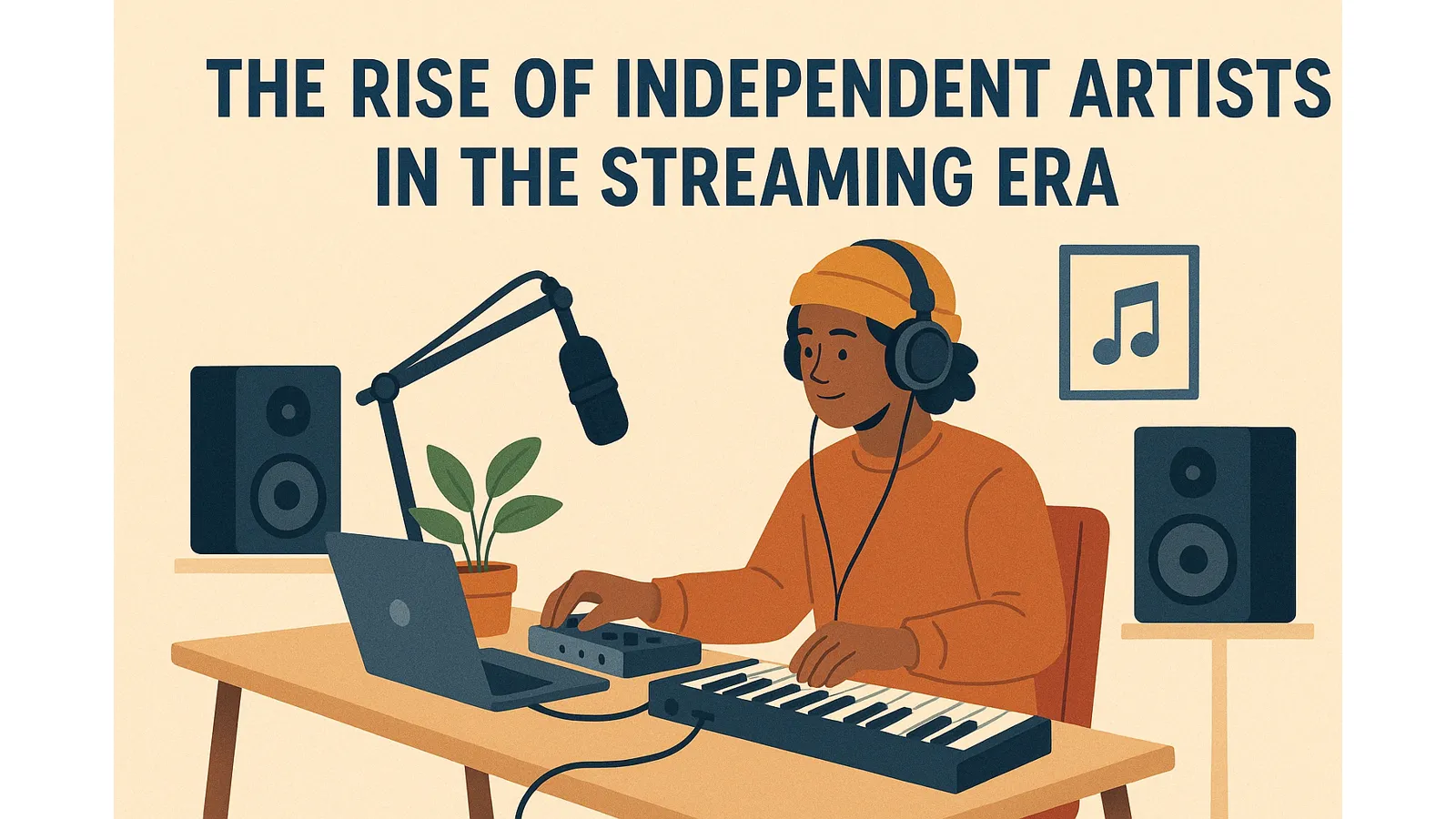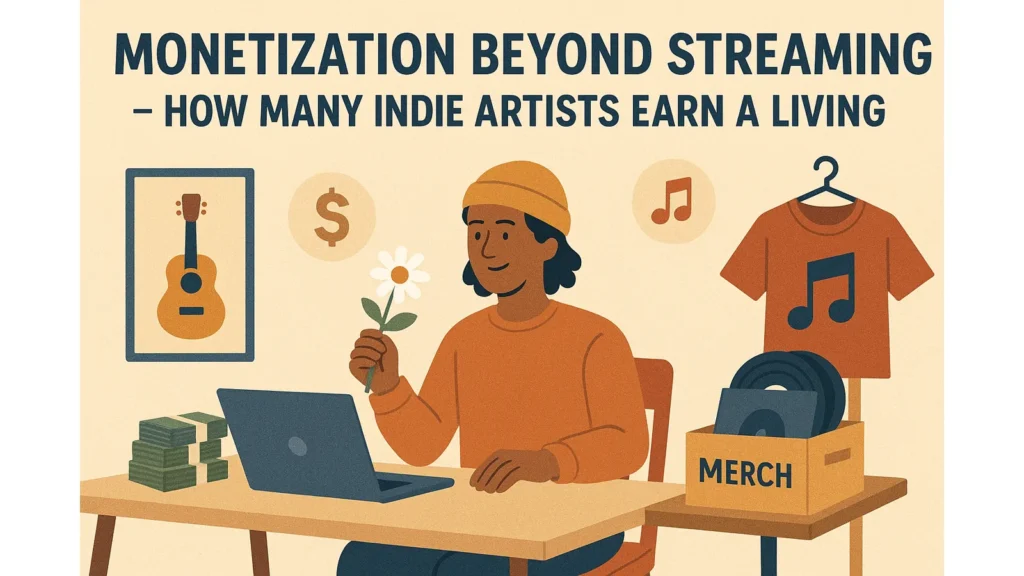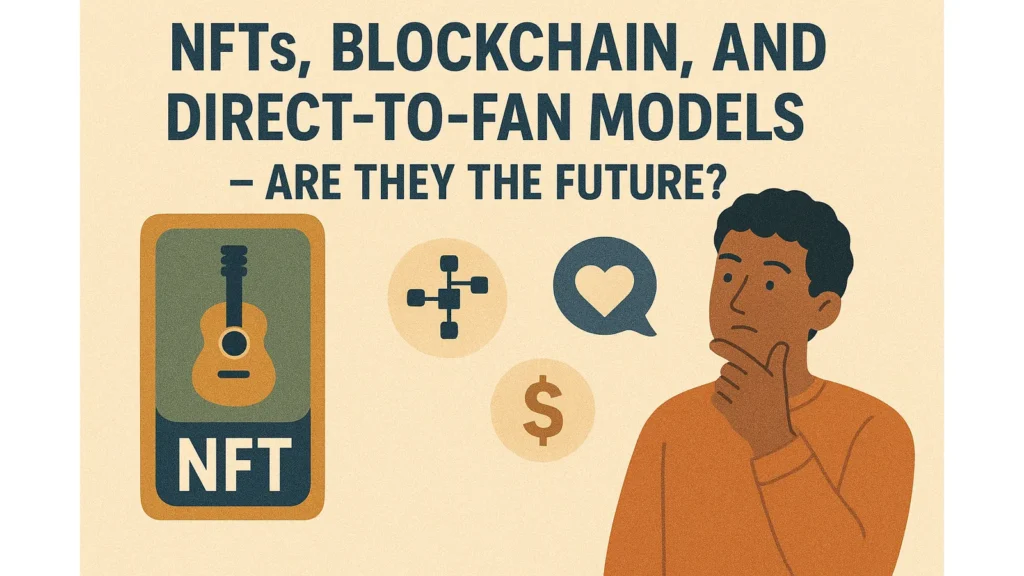
Indie music has always been about pushing boundaries, embracing creative freedom, and defying mainstream expectations. From its early DIY roots in underground scenes to becoming a global force, the independent music landscape has evolved dramatically.
Today, indie artists are no longer limited by physical record sales or radio airplay. Instead, they leverage the power of streaming platforms, social media, and independent labels to reach global audiences without the need for major record companies.
The digital revolution has given independent artists more control over their music, allowing them to release albums on their own terms. Platforms like Spotify, Apple Music, and Bandcamp have eliminated traditional gatekeepers, empowering more artists to connect directly with fans.
This has led to a more diverse musical landscape, where new sounds constantly emerge, blending elements from pop music, alternative rock, and indie folk into fresh sonic experiences.
However, with the evolving nature of digital platforms come new challenges. The rise of algorithm-driven recommendations means that indie musicians must strategically position themselves to get noticed.
While this offers an opportunity for many indie artists to gain significant success, it also creates a competitive space where standing out requires more than just great music. It demands smart marketing, audience engagement, and adaptability.
In the following sections, we’ll explore how independent distributors, social media, and alternative revenue streams are shaping the future of indie music, giving more artists the chance to remain independent while achieving commercial success.
The Rise of Independent Artists in the Streaming Era
The internet has completely changed how we consume music, and no group has benefited more from this transformation than independent artists. In the past, breaking into the music industry required signing with a major label, relying on radio play, and touring extensively.
Now, thanks to streaming platforms like Spotify, Apple Music, and Bandcamp, many indie artists can reach global audiences without the backing of major record companies.
How Streaming Platforms Empower Independent Artists
Platforms like Spotify and Apple Music have given indie artists a global stage, allowing them to push boundaries without industry restrictions. Some major advantages include:
- Instant global reach: Unlike traditional distribution methods, streaming allows artists to release their music instantly and reach listeners worldwide.
- Creative control: Artists don’t need to compromise their sound to fit a label’s expectations.
- Direct fan engagement: Streaming allows for data-driven insights, helping artists understand their audience better.
Additionally, platforms like Bandcamp enable artists to sell their music directly to fans, keeping a larger share of their earnings compared to streaming royalties. According to Bandcamp’s official stats, an average of 82% of each sale goes directly to the artist. This direct-to-artist model makes it a vital platform for independent labels and musicians alike.
The Algorithm Game – How Indie Artists Can Stand Out
While streaming provides opportunities, it also presents a challenge: getting noticed. With millions of tracks uploaded every month, indie musicians must find ways to work within AI-driven algorithms to increase visibility.
How Algorithms Shape Music Discovery
Platforms like Spotify use machine learning to recommend songs based on listening habits. Playlists like Discover Weekly and Release Radar introduce users to new artists, and making it onto one of these playlists can be a game-changer. Research from MIDiA Research indicates that over 30% of streams on Spotify come from algorithmic recommendations.
Best Practices for Indie Artists to Maximize Exposure
To stand out in the streaming era, indie artists should:
- Release music consistently – Regular releases signal activity to streaming algorithms, increasing the chances of playlist placement.
- Encourage pre-saves – Platforms like Spotify reward artists who get pre-saves before their release date, boosting early visibility.
- Engage fans on social media – High engagement on platforms like TikTok, Instagram, and Twitter can drive streams and help music trends.
- Submit to playlist curators – Editorial and user-curated playlists remain one of the best ways to gain traction.
Artists like Tame Impala and Arctic Monkeys have successfully used these tactics to maintain their indie credibility while achieving mainstream success.
Monetization Beyond Streaming – How Many Indie Artists Earn a Living
While streaming platforms provide exposure, they often fall short in terms of revenue. According to a report by Business Insider, artists earn as little as $0.003 to $0.005 per stream on Spotify, meaning an independent artist would need at least 250,000 streams per month just to earn $1,000. Because of this, many indie artists are looking for alternative ways to fund their careers.

Diversifying Income Streams – Key Monetization Methods
To sustain themselves, independent artists are turning to multiple revenue streams beyond streaming royalties. Here are some of the most effective methods:
1. Crowdfunding & Fan-Funded Models
Crowdfunding has become a lifeline for indie musicians, allowing them to finance albums, tours, and merchandise directly through fan support. Platforms like Patreon and Kickstarter have allowed artists to remain independent while receiving direct fan support through recurring donations.
A great success story is Amanda Palmer, who raised over $1.2 million on Kickstarter to fund her album and tour. She has since continued funding her music through Patreon, where she earns over $50,000 per month from subscribers.
2. Merchandise Sales & Exclusive Content
Selling physical and digital merchandise provides indie musicians with a major income boost. Popular options include:
- Vinyl, CDs, and cassettes – Physical formats remain popular, especially in the indie scene. According to the RIAA, vinyl sales surpassed CD sales in 2022 for the first time in decades.
- T-shirts, posters, and accessories – Many indie labels and artists rely on branded merchandise to strengthen their connection with fans.
- Exclusive digital content – Bonus tracks, live recordings, and behind-the-scenes content are often sold through platforms like Bandcamp and Patreon.
3. Sync Licensing & Music Placement
Getting songs placed in films, TV shows, video games, and commercials can be one of the most lucrative opportunities for independent artists. Music licensing deals, also known as sync licensing, allow artists to earn one-time fees and royalties.
For example, the band Vampire Weekend saw a massive surge in popularity when their music was featured in TV commercials and soundtracks. Similarly, Tame Impala gained mainstream recognition after placements in HBO series and big-budget ad campaigns.
Artists can submit their music to licensing platforms like Musicbed and Songtradr to increase their chances of securing placements.
NFTs, Blockchain, and Direct-to-Fan Models – Are They the Future?
With technology advancing, many artists are experimenting with NFTs and blockchain to create new monetization models.

1. Blockchain & Decentralized Music Ownership
Blockchain technology allows independent artists to sell music directly to fans, cutting out record labels and streaming services altogether. Platforms like Audius offer artists a way to distribute music without middlemen, giving them full creative control and higher revenue shares.
2. NFTs as a Fan-Support Model
NFTs (non-fungible tokens) have emerged as a way for fans to own unique digital assets, such as:
- Exclusive music releases
- Limited-edition album artwork
- VIP concert experiences
In 2021, Kings of Leon became the first band to release a streaming-only album as an NFT, earning over $2 million (source). While NFTs remain a controversial topic, they provide independent artists with an alternative revenue model.
Is This the Future?
While blockchain music and NFTs offer exciting possibilities, they also raise concerns about sustainability and accessibility. Many artists and fans remain sceptical, questioning whether these trends will become a mainstream culture or simply a fad.
How Independent Music is Redefining Genre Boundaries
One of the most exciting aspects of the indie music scene is its ability to push boundaries and blend diverse styles. While mainstream artists often stick to formulaic sounds, independent artists have the freedom to experiment, creating new sounds that challenge traditional music industry norms.
Over the past decade, the indie scene has evolved beyond its alternative rock roots, embracing elements of hip-hop, electronic, folk, and experimental music.
The Blurred Lines Between Indie and Mainstream
Once considered a niche, indie music’s influence has now spread into mainstream culture. Bands like Arctic Monkeys and Tame Impala started with a DIY ethos, yet they’ve managed to achieve commercial success while retaining their independent spirit. The same goes for indie folk acts like Bon Iver, whose atmospheric production techniques have influenced even major pop music artists.
Many independent labels now collaborate with major record companies, leading to new artists who straddle both worlds. For example, Phoebe Bridgers, originally signed to the indie label Dead Oceans, later worked with mainstream artists while maintaining full creative control. This shift demonstrates how the music landscape is constantly evolving, allowing many indie artists to find success without compromising their artistic vision.
The Fusion of Indie with Other Genres
Some of the most innovative trends in independent music today include:
Indie Rock Meets Hip-Hop: Artists like Dominic Fike and BROCKHAMPTON blend indie rock instrumentation with hip-hop beats, attracting fans from both genres.
Electronic & Indie Pop Crossovers: Acts like The 1975 and Christine and the Queens merge electronic production with indie sensibilities, creating new music that feels fresh and dynamic.
Jazz & Alternative R&B Influence: The rise of artists like Tom Misch and Anderson . Paak shows how many indie artists are incorporating jazz, soul, and funk into their work.
According to Rolling Stone, the modern indie scene thrives on cross-genre collaboration, reflecting the diverse music consumption habits of today’s listeners.
Indie Musicians Leading Innovation
Because independent artists aren’t bound by major label restrictions, they can experiment with unconventional production techniques. Many are also pioneering sustainable recording practices, using home studios and collaborating remotely to reduce costs.
In an era where streaming platforms dominate, genre labels have become less relevant. Instead, many artists focus on creating music directly for their audiences rather than fitting into a specific scene. This has led to an explosion of creativity, where new artists blend styles freely, shaping the future of indie music.
The Role of Social Media & Community Building for Indie Artists
In today’s music industry, being an indie artist isn’t just about making great music. It’s about building a loyal fanbase. Social media has become a game-changer for independent artists, offering them a direct line to their audience without needing a major label.

Platforms like TikTok, Instagram, Twitter, and YouTube have helped many indie artists achieve significant success, turning viral moments into thriving careers.
How Social Media Shapes Indie Music Trends
The power of social media in the indie music scene is undeniable. A single viral video can turn a debut single into a global hit overnight.
Artists like Arctic Monkeys and Vampire Weekend built their early followings through MySpace and music blogs, while modern artists use platforms like TikTok and Instagram Reels to promote their music.
Key ways social media benefits independent musicians:
- Viral Music Trends: Songs that take off on TikTok often see a massive streaming boost. For example, PinkPantheress, an independent artist, gained mainstream success after her tracks went viral on TikTok (source).
- Direct Fan Engagement: Platforms like Twitter and Discord allow indie musicians to interact with fans, strengthening their community.
- DIY Promotion: Without the need for major record companies, artists can use Instagram Stories, live streams, and crowdfunding campaigns to promote releases.
Case Studies – Indie Artists Who Built Careers on Social Media
Many independent artists have leveraged social media to grow their careers. Some notable success stories include:
- Beabadoobee – Started by sharing DIY music on YouTube and SoundCloud, later signed to an independent label and is now one of the biggest names in the indie scene.
- Lil Nas X – Used TikTok virality to turn “Old Town Road” into a record-breaking hit, proving that many artists can achieve commercial success without traditional backing.
- Cavetown – Built a fanbase through direct fan engagement on YouTube, Patreon, and Discord, proving that independent music can thrive through community building.
Touring & Sustainability – How Indie Artists Adapt to a Changing Industry
For decades, live performances have been one of the most important income sources for independent musicians. However, the COVID-19 pandemic forced many artists to rethink traditional touring. As a result, the indie scene has embraced new ways to perform and earn income sustainably.

1. Virtual and Hybrid Concerts
With in-person shows limited for a time, many indie musicians turned to virtual performances. Platforms like Twitch and StageIt allowed artists to perform live while interacting with fans in real time. Even now, many artists remain independent by combining live performances with virtual events to reach global audiences.
2. Sustainable Touring Practices
Many independent artists are also adopting eco-conscious touring practices, such as:
- Reducing carbon footprints by using electric vehicles and eco-friendly merchandise.
- Partnering with sustainable venues to minimize waste.
- Performing locally and organizing community-based events instead of extensive travel.
According to a report from Billboard, more artists are prioritizing sustainability in their tours, proving that the music industry is evolving beyond traditional models.
What’s Next? The Future of Indie Music Trends
As the music industry continues to evolve, so too does the indie music scene. With rapid advancements in technology and shifting fan behaviors, the next five years promise to be an exciting time for independent artists.
1. The Role of AI, AR, and VR in Indie Music
Artificial intelligence (AI) is already shaping the way many indie artists create and distribute their music. AI-powered mastering services, like LANDR, allow musicians to produce studio-quality sound without the need for expensive engineers. Additionally, AI-driven recommendation algorithms will continue to influence music consumption, helping indie musicians gain visibility.
Meanwhile, augmented reality (AR) and virtual reality (VR) could transform the way fans experience live performances. Platforms like Wave already offer virtual concerts, allowing fans to enjoy immersive live performances from anywhere in the world.
2. The Continued Battle Between Independence and Major Label Influence
While many artists continue to remain independent, there’s still a growing trend of independent labels partnering with major record companies for distribution and marketing. Some argue that this could dilute the DIY ethos of independent music, while others see it as an opportunity for indie artists to reach global audiences without sacrificing their creative control.
One thing is certain: independent music will continue to thrive as long as artists have the freedom to push boundaries, create new sounds, and connect with fans on their own terms.
The Power of Independent Music & How You Can Support It
The beauty of independent music lies in its authenticity, creativity, and resilience. Unlike major record companies, which prioritize mainstream success, indie labels and many indie artists focus on artistic expression and direct fan engagement.
If you love discovering new artists and want to support the indie scene, here’s how you can make a difference:
- Buy music directly from Bandcamp or independent distributors instead of only streaming.
- Attend live performances or virtual concerts to support touring artists.
- Purchase merchandise to help independent musicians earn a living.
- Follow and share indie artists on social media to boost their reach.
At Fleeting Youth Records, we embrace the essence of indie music by nurturing new artists and showcasing the finest in the independent music realm. Explore our latest releases and help shape the future of indie music today!